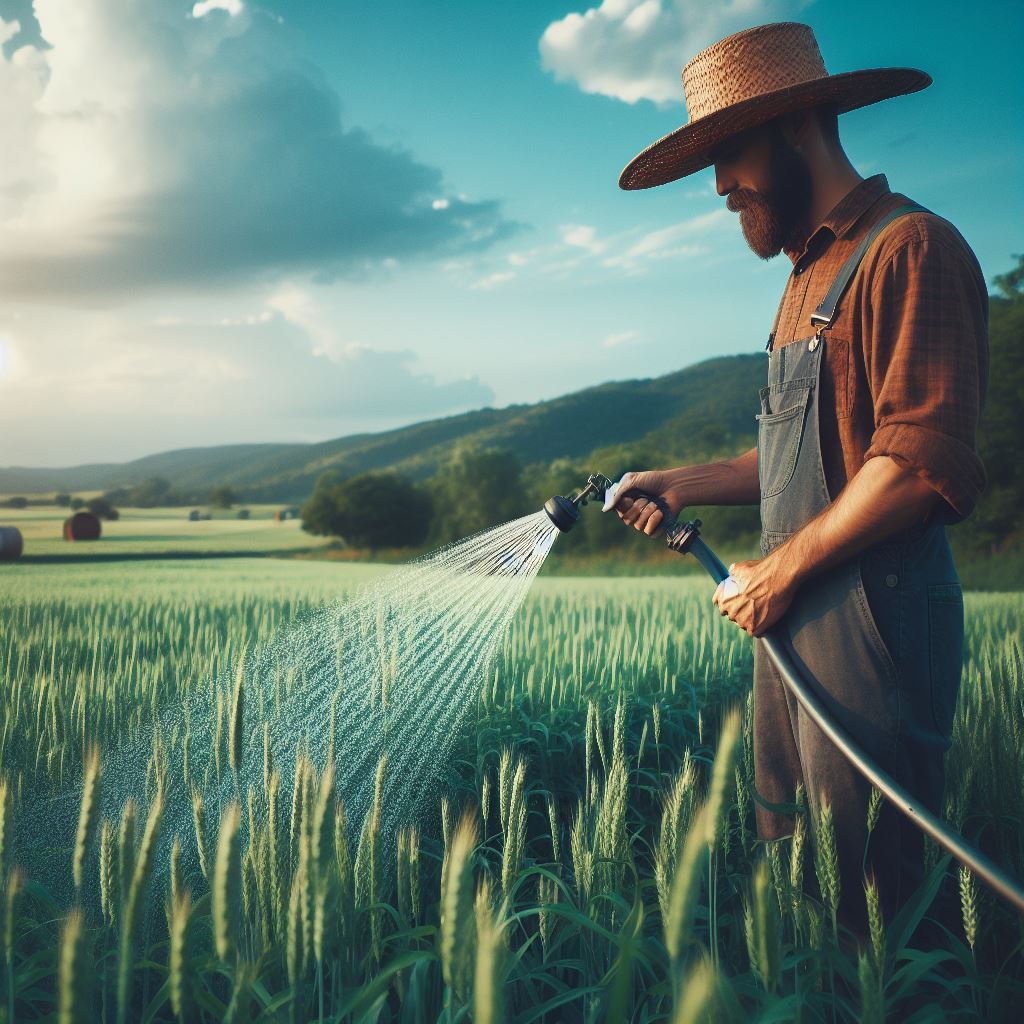Introduction
Briefly explain the importance of crop diversity in agriculture
Crop diversity plays a vital role in agriculture as it enhances resilience against pests and diseases.
Crop diversity in agriculture is vital for resilience and sustainability. It enhances soil health, reduces vulnerability to pests and diseases, and improves ecosystem stability.
Diverse crops offer adaptability to changing climate conditions, ensure food security by providing varied nutrients, and support biodiversity, fostering a more resilient and productive agricultural system.
Purpose of the blog post
The purpose of this blog post is to shed light on the benefits of crop diversity.
Definition of Crop Diversity
Define what crop diversity is
Crop diversity refers to the variety of different crops that are grown in a particular region or ecosystem.
Different types of crop diversity
Genetic Diversity
Genetic diversity refers to the variation in genetic traits within a particular crop species. It includes differences in traits like yield potential, disease resistance, and nutrient content.
Species Diversity
Species diversity focuses on the number of different crop species that are cultivated in a particular area. It is important for maintaining a healthy and resilient agricultural system.
Agroecological Diversity
Agroecological diversity refers to the different agricultural practices and systems used to cultivate crops. These practices can include methods like organic farming, agroforestry, and crop rotation.
Functional Diversity
Functional diversity refers to the various functions that crops can perform in an ecosystem. This can include providing food and nutrition, promoting biodiversity, improving soil health, and mitigating climate change.
Cultural Diversity
Cultural diversity emphasizes the importance of preserving traditional crop varieties that are deeply rooted in local cultures and food systems. These crops often have unique flavors and nutritional profiles.
Landscape Diversity
Landscape diversity considers the spatial arrangement and diversity of crops within a landscape. It includes factors like the distribution of different crop types, field sizes, and crop rotations.
Market Diversity
Market diversity focuses on the availability of a wide range of crop options for consumers. It ensures that consumers have access to diverse and nutritious food choices.
Nutritional Diversity
Nutritional diversity emphasizes producing and consuming a wide range of nutrient-rich crops to improve human health and combat malnutrition.
Temporal Diversity
Temporal diversity refers to the different time periods during which different crops are grown. It includes the use of crop rotations and intercropping to optimize resource utilization and reduce pest and disease pressure.
Resilience and Adaptation
Crop diversity plays a crucial role in enhancing the resilience and adaptability of agricultural systems to various environmental stresses, such as climate change, pests, and diseases.
In general, crop diversity encompasses various dimensions, including genetic, species, agroecological, functional, cultural, landscape, market, nutritional, temporal, and resilience aspects.
Transform Your Agribusiness
Unlock your farm's potential with expert advice tailored to your needs. Get actionable steps that drive real results.
Get StartedEach type of crop diversity contributes to the overall sustainability and productivity of agricultural systems. By acknowledging and promoting crop diversity, we can mitigate risks, protect food security, and preserve the health of our planet.
Read: Improving Soil: Natural Methods
Benefits of Crop Diversity
Crop diversity offers numerous benefits that contribute to the overall health and sustainability of our agricultural systems. By cultivating a variety of crops, farmers can enhance ecosystem services, increase resilience to climate change, and improve food security.
Enhanced ecosystem services
One significant benefit of crop diversity is the enhanced ecosystem services it provides.
Improve soil health and fertility
Different crops have varying root depths and structures, which can improve soil health and fertility.
This diversity helps to prevent soil erosion, promotes nutrient cycling, and enhances water filtration.
Reduce the need for synthetic fertilizers and pesticides
By avoiding monocultures and promoting crop rotation, farmers can reduce the need for synthetic fertilizers and pesticides, reducing the environmental impact of agriculture.
Increased resilience to climate change
Furthermore, crop diversity plays a crucial role in increasing resilience to climate change.
Different crops adapt to varying environmental conditions
Different crops adapt to varying environmental conditions, such as temperature, moisture levels, and soil types. By growing a diverse range of crops, farmers can better withstand extreme weather events such as droughts, floods, and heatwaves.
More resistant to pests, diseases, and extreme weather events
Additionally, diverse crops are more resistant to pests and diseases, reducing the reliance on chemical pesticides and minimizing crop losses.
Improved food security
Improved food security is another significant advantage of crop diversity.
Diverse crops provide a wider range of nutrients
Diverse crops provide a wider range of nutrients, which is essential for a balanced and healthy diet. Different crops have varying nutritional profiles, ensuring that people have access to a diverse range of essential vitamins and minerals.
Reduces the risk of crop failures and dependence on single crops
Additionally, crop diversity reduces the risk of crop failures. If a disease or pest affects one crop, other crops can still thrive, ensuring a steady food supply.
Moreover, relying on a single crop can lead to vulnerability and dependence. If a single crop fails due to factors such as pests, diseases, or weather events, it can have severe consequences for farmers and communities.
Crop diversity reduces this risk by spreading it over different crops, ensuring that a total crop failure is less likely to occur. This diversification also reduces the reliance on a small number of crops, promoting a more resilient and sustainable agricultural system.
To summarize, the benefits of crop diversity are undeniable. It enhances ecosystem services by improving soil health and reducing the need for synthetic inputs.
Furthermore, it increases the resilience of agricultural systems to climate change and reduces the risk of crop failures and food insecurity.
It is essential to promote and support farmers in cultivating a diverse range of crops to ensure a sustainable and secure food future.
Read: No-Till Farming: Pros & Cons
Examples of Crop Diversity Initiatives
Crop diversity initiatives play a fundamental role in sustaining agricultural systems and ensuring long-term food security.
By adopting practices like crop rotation, intercropping, and seed preservation, farmers can unlock a multitude of benefits that positively impact both the environment and productivity.
Crop rotation
What is crop rotation and how does it benefit agriculture?
Crop rotation is the practice of growing different crops in succession on the same piece of land. It is beneficial because it helps control pests and diseases, improves soil fertility, and enhances crop yield.
Crop rotation, the practice of sequentially growing different crops on a piece of land, offers numerous advantages. It helps break pest and disease cycles by interrupting their life cycles, reducing the need for chemical pesticides.
Additionally, crop rotation improves soil fertility through nutrient cycling and reduces soil erosion, ultimately leading to higher crop yields and better overall plant health.
Showcase Your Farming Business
Publish your professional farming services profile on our blog for a one-time fee of $200 and reach a dedicated audience of farmers and agribusiness owners.
Publish Your ProfileExamples of crop rotation practices
One example of crop rotation is alternating between corn and soybeans, as corn depletes the soil of nitrogen while soybeans replenish it. Another example is rotating root crops with leafy vegetables to prevent soil-borne diseases and improve nutrient availability.
Implementing crop rotation involves various practices. For instance, farmers can alternate between crops with different nutrient requirements, such as planting nitrogen-fixing legumes after nitrogen-demanding crops.
This ensures that the soil remains enriched with essential nutrients. Another approach is rotating crops with different root structures, which helps prevent soil compaction and the buildup of harmful pathogens.
Intercropping
Definition and advantages of intercropping
Intercropping involves growing two or more crops simultaneously in the same field. It provides several advantages, including efficient use of resources, pest and disease control, and increased biodiversity.
Intercropping, an agricultural technique that involves growing multiple crops together in the same field, also contributes to crop diversity.
It promotes efficient resource utilization, as different crops have varying nutrient requirements and growth patterns.
Intercropping can also enhance pest control through the use of companion planting, where one crop repels pests that would otherwise attack the companion crop.
Successful intercropping systems
An example of a successful intercropping system is growing maize and climbing beans together, where the beans provide support for the maize and fix nitrogen in the soil. Another example is planting legumes with cereals to improve nitrogen fixation and overall productivity.
Successful intercropping systems are abundant. One example is growing maize and climbing beans together. The beans provide a natural trellis for the maize, reducing the need for artificial support structures.
Furthermore, beans fix nitrogen in the soil, benefiting both crops. Another successful intercropping practice is integrating legumes with cereals. Leguminous plants, such as peas and lentils, fix atmospheric nitrogen, which increases soil fertility and productivity.
Seed preservation and conservation
Significance of preserving traditional and heirloom seeds
Preserving traditional and heirloom seeds is crucial for maintaining crop diversity, as they possess unique traits and genetic variations that contribute to the resilience and adaptability of agricultural systems.
These seeds often carry unique traits and genetic variations that enable plants to withstand diverse environmental conditions, pests, and diseases.
By conserving them, we protect the resilience and adaptability of our agricultural systems in the face of changing climates and emerging challenges.
Initiatives or organizations involved in seed conservation
Several initiatives and organizations are actively involved in seed conservation, such as the Slow Food Ark of Taste, which aims to protect traditional and endangered food products.
It also aims to protect traditional and endangered food products, including heirloom plant varieties. By promoting the consumption and cultivation of these foods, the organization encourages farmers and consumers to play an active role in preserving agricultural biodiversity.
The Svalbard Global Seed Vault in Norway is another project dedicated to preserving seeds from all over the world in a secure facility.
Additionally, the Svalbard Global Seed Vault in Norway serves as a fail-safe storage facility for seeds from around the world, ensuring their preservation even under extreme circumstances.
Essentially, crop diversity initiatives like crop rotation, intercropping, and seed preservation are vital for sustainable agriculture.
These practices promote the efficient use of resources, enhance pest and disease control, and preserve the genetic diversity necessary for resilient and productive farming systems.
By embracing and supporting these initiatives, we contribute to a more sustainable and secure food future.
Read: Boost Yields with Crop Diversity

Challenges and Constraints
Industrial Agriculture Practices and Monoculture
Industrial agriculture has greatly reduced crop diversity due to its focus on large-scale production of a limited number of crops.
Monoculture farming, which involves growing a single crop on a large scale, presents several problems:
Increased vulnerability to pests and diseases due to the lack of genetic diversity.
Higher dependence on synthetic fertilizers, pesticides, and herbicides.
Depletion of soil nutrients and degradation of soil health over time.
Reduced resilience to climate change and extreme weather events.
Market Demand and Monoculture-driven Supply Chains
Market preferences and consumer demand heavily influence farmers’ decisions on what crops to grow.
However, this demand often favors a limited range of crops, leading to reduced crop diversity:
Consumers prioritize certain crops, such as wheat, rice, and corn, which dominate the market.
Large-scale buyers and supply chains reinforce monoculture production to meet consistent demand.
This reduced diversity limits the availability of locally adapted crops and traditional varieties.
It also reduces the resilience and adaptability of agricultural systems to changing conditions.
Small-scale farmers face numerous challenges in diversifying their crops
Limited access to information and resources on alternative crops and methods.
Insufficient market incentives and price premiums for niche and diverse crops.
Inadequate infrastructure, storage, and transportation facilities for handling diverse produce.
Risk aversion due to uncertainty in market demand and potential financial losses.
Lack of technical knowledge and training on crop diversification techniques.
Overcoming these challenges requires a multi-faceted approach
Education and training programs to empower small-scale farmers with knowledge and skills.
Investment in research and development for regionally suitable crop varieties.
Showcase Your Farming Business
Publish your professional farming services profile on our blog for a one-time fee of $200 and reach a dedicated audience of farmers and agribusiness owners.
Publish Your ProfileGovernment policies and incentives to promote diversified farming systems.
Support for market access and infrastructure development, including cold storage and processing facilities.
Collaboration between farmers, consumers, and agribusinesses to create demand for diverse crops.
By addressing these challenges, we can encourage a shift towards diversified agricultural systems
Increased crop diversity can enhance ecosystem resilience, reducing the need for synthetic inputs.
Greater genetic diversity can provide buffers against pests, diseases, and climate-related risks.
Local and traditional crop varieties can be preserved, protecting cultural heritage and food security.
Diversified farming systems can enhance soil health, promote biodiversity, and improve ecosystem services.
Consumers can enjoy a wider range of nutritious and flavorful crops, supporting local economies.
Ultimately, industrial agriculture practices and market-driven demand have contributed to the reduction in crop diversity. However, small-scale farmers face numerous challenges in diversifying their crops.
Overcoming these constraints requires a comprehensive approach involving education, research, policy support, infrastructure development, and collaboration.
By promoting crop diversity, we can foster sustainable and resilient agricultural systems that benefit both farmers and the environment.
Read: Pest Control in Sustainable Farming
Solutions and Recommendations
Having discussed the benefits of crop diversity, it is essential to explore the solutions and recommendations to further promote its importance.
This section will focus on the role of the government in supporting diverse cropping systems and the need for consumer awareness.
Government support and policies
The government plays a significant role in promoting crop diversity through its supportive policies and initiatives. By recognizing the importance of diverse crops, policymakers can influence farmers to adopt sustainable farming practices.
Role of government in promoting crop diversity
The government needs to actively engage in conversations about the benefits of crop diversity, emphasizing its positive impact on agricultural sustainability and food security.
This can be done through public awareness campaigns, educational programs, and partnerships with agricultural institutions.
Policies or incentives to encourage diverse cropping systems
The government should offer financial incentives to farmers who implement diverse cropping systems. These incentives can include tax benefits, grants for crop diversification initiatives, and subsidies for soil health improvement.
Additionally, the government should provide technical support and training to farmers, enabling them to transition to diverse farming practices successfully.
Consumer awareness and demand for diverse crops
Consumer education and awareness play a crucial role in creating a demand for diverse crops. By informing consumers about the benefits and significance of crop diversity, they can make informed choices while purchasing agricultural products.
Importance of consumer education on crop diversity
Consumers need to understand that their choices have an impact on the agricultural industry and the environment.
Educating consumers about the benefits of diverse crops, such as improved nutrition, reduced pesticide use, and enhanced ecosystem resilience, can inspire them to support sustainable farming practices.
Encouraging consumers to support local, diverse farming practices
Consumer preferences play a vital role in shaping agricultural practices. By choosing locally grown and diverse crops, consumers can directly contribute to the promotion of crop diversity.
Encouraging farmers’ markets, community-supported agriculture programs, and farm-to-table initiatives can strengthen the bond between consumers and local farmers.
Therefore, addressing the challenges related to crop diversity requires collective efforts from the government and consumers.
The government should actively promote diverse cropping systems through supportive policies and incentives, while consumers need to be educated about the significance of crop diversity and encouraged to support diverse farming practices.
By working together, we can ensure a sustainable and resilient future for our agricultural systems.
Uncover the Details: IPM: Maximizing Crop Production
Uncover the Details: Soil Health: Signs & Improvement Tips
Conclusion
Summary of the key points discussed in the blog post
In summary, this blog post highlighted the benefits of crop diversity in agriculture.
Crop diversity plays a crucial role in ensuring sustainable agriculture and food security. As discussed in this blog post, having a variety of crops has numerous benefits that help farmers and the environment.
Firstly, crop diversity promotes resilience in the face of climate change. Different crops have different tolerances to heat, drought, and pests.
By cultivating a range of crops, farmers can mitigate the risks of crop failure due to extreme weather events or the spread of diseases and pests. This ensures a stable food supply and reduces the vulnerability of farmers to climate-related challenges.
Secondly, crop diversity improves soil health and fertility. Growing a single crop year after year depletes the soil of specific nutrients.
However, by rotating crops, farmers can naturally replenish the soil with the nutrients required by each crop. This reduces the need for synthetic fertilizers and keeps the soil fertile for future plantings.
Furthermore, crop diversity enhances biodiversity. Different crops attract different insects, birds, and beneficial organisms, creating a balanced ecosystem.
This helps to control pests naturally and reduces the reliance on pesticides. Additionally, crop diversity provides habitats and food sources for a wide range of species, contributing to overall ecosystem health.
Emphasis on the significance of crop diversity for sustainable agriculture and food security
It is crucial to recognize the significance of crop diversity for sustainable agriculture and food security.
Overall, crop diversity is not only beneficial to farmers but also vital for sustainable agriculture and food security. By recognizing its significance, we can promote a more resilient and sustainable farming system.
Showcase Your Farming Business
Publish your professional farming services profile on our blog for a one-time fee of $200 and reach a dedicated audience of farmers and agribusiness owners.
Publish Your ProfileEmphasizing the importance of crop diversity will ultimately contribute to the long-term well-being of our planet and ensure a reliable and diverse supply of food for generations to come.




